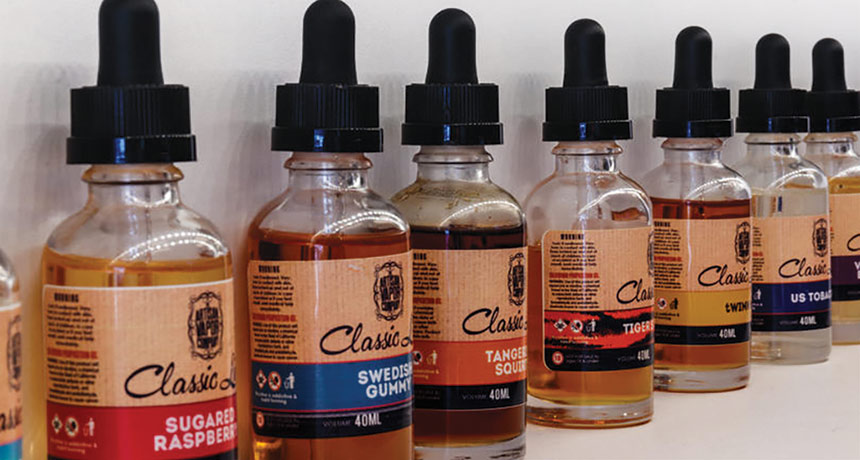
NOT SO SWEET When added to e-liquids, sucralose can increase the amount of toxic aldehydes and create harmful chlorinated chemicals.
Jonathan Weiss/Alamy Stock Photo
- More than 2 years ago
Lacing e-cigarette liquid with sucralose is probably not a sweet idea. Vaping the synthetic sweetener may generate harmful chemicals, researchers report May 13 in Chemical Research in Toxicology.
“I would strongly advise that users should not use liquids with sucralose in them,” says Sven Jordt, a toxicologist at Duke University School of Medicine who was not involved with the study.
Many e-cigarette users, especially teenagers (SN: 12/22/18, p. 28), are drawn to sweet and fruity flavored e-liquids. But because of lax labeling rules, it’s not clear which e-cigarettes include sucralose and how much they contain. The popular Juul brand does not contain sucralose, Jordt says. Manufacturers also sell concentrated sucralose solutions for users who mix their own e-juice.
Sucralose, sold under the brand name Splenda for use in food and drink, is hundreds of times sweeter than table sugar and is generally considered safe for food. But little is known about its toxicity when inhaled. “Those evaluations are for eating, and it turns out the lung and the stomach are not the same target organ,” says study coauthor David Peyton, a chemist at Portland State University.
Familiar with the chemistry of sucralose, Peyton and his team had a hunch that the compound might break down when heated by the metal coils inside e-cigarettes. To test the idea, they mixed up e-liquids and vaporized them using commercial devices in the lab. A pump drew air through the e-cig, and the scientists captured the puffs of vapor for analysis.
Adding sucralose to a mix of typical e-liquid solvents, propylene glycol and glycerol, amplified the production of lung-irritating compounds called aldehydes by a factor of three to 10. Some of these compounds, including acetaldehyde and acrolein, are known to be toxic. The amount of aldehydes a user inhales would depend on factors including how concentrated the sucralose is and how hot the coil gets, Peyton says.
The scientists also detected small amounts of organochlorines, including a potential carcinogen, in the vapor from e-liquids containing sucralose. While the effects of inhaling organochlorines aren’t fully understood, some of these compounds are “notorious for horrendous long term toxicological effects,” Jordt says.
Sucralose looks a lot like table sugar, but the molecule trades three of sugar’s hydroxyl groups for chlorine atoms. When sucralose breaks down, chloride ions are released and can hook up with other chemicals and intervene in other reactions occurring in the device. When vaped, sucralose degrades, hydrochloric acid likely forms and catalyzes the reactions that produce the aldehydes, the study suggests. The authors also detected hemiacetal compounds, which can contribute to the total aldehyde levels, and acetals, another set of lung-irritating chemicals.
The hydrochloric acid also seems to mess with the e-cigs’ nicotine. When sucralose is around, some nicotine is converted to a form less easily absorbed by the body. Thus some may end up vaping more to get the same hit of nicotine, Jordt says. This may occur with heavy users, Peyton says, but for less experienced vapers, the nicotine’s transformation may cut its harshness and make it less off-putting.
And with all those potential hazards, sucralose isn’t actually very effective in sweetening e-cigarettes. As a heavy molecule, it doesn’t easily waft with vapor. That means users may get only a little sweetness from it.






